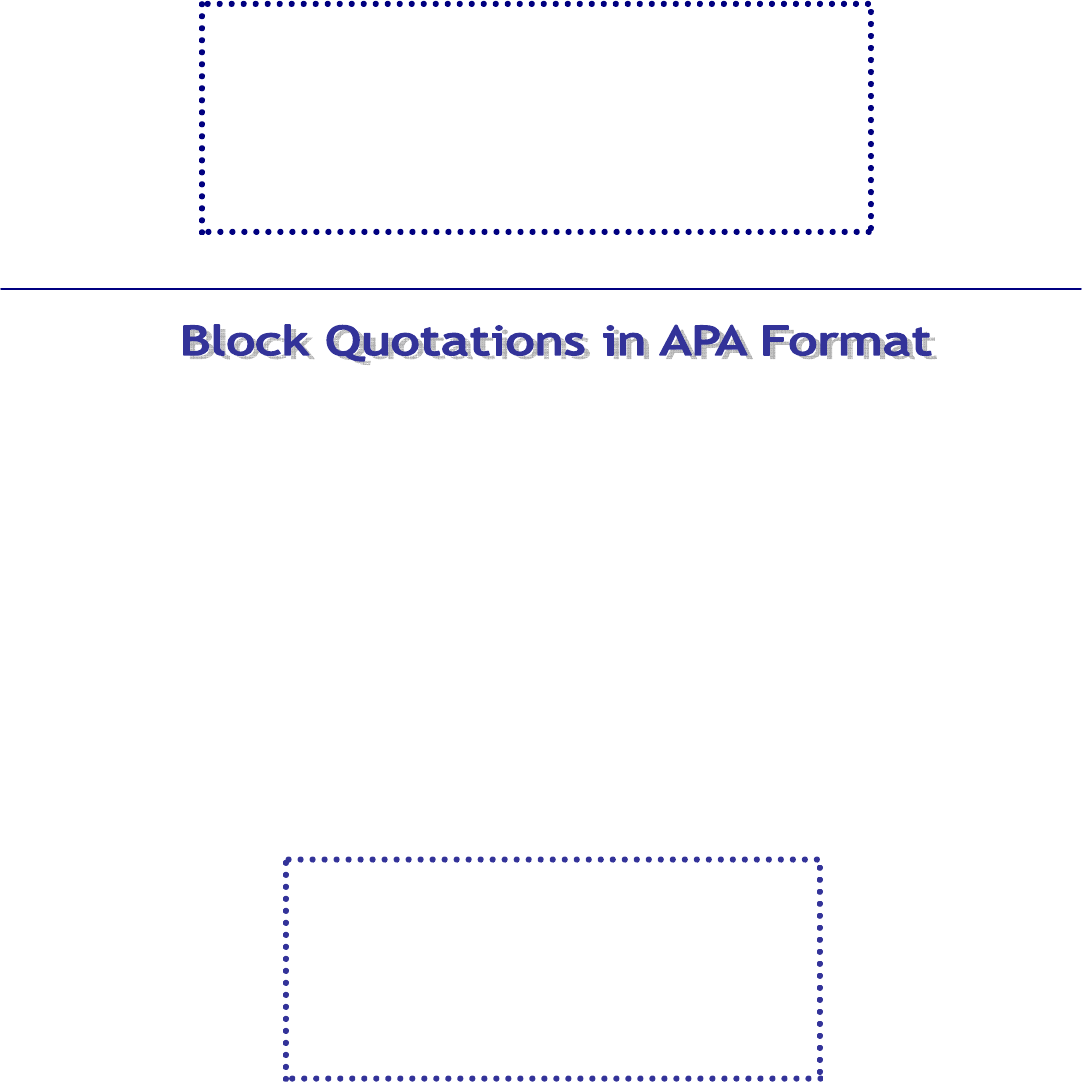
When directly quoting from a source, the author’s last name, the year of publication, and the page num-
ber where the quote was found needs to be present in the citation. This can be done in one of two ways.
WHY USE QUOTATIONS?
Use them to support your argument.
Use them to compare claims in multiple works for the purpose of analysis.
WHEN SHOULD I USE THEM?
Use them to preserve the wording of the original author because
the author is an authority, or
the passage is well-phrased, vivid, or dramatic, or
the passage might be misinterpreted if expressed in other words.
WHEN SHOULDN’T I USE THEM?
A general rule of thumb is that no more than fifteen percent of your paper should be quoted material. There-
fore, when you can convey the idea just as effectively in your own words through the use of summary or para-
phrase, do so. The purpose of using outside sources is to support your own ideas. “Source stringing” occurs
when the amount of outside material is equal to or greater than your own original ideas.
ARE THERE DIFFERENT WAYS TO FORMAT DIRECT QUOTATIONS?
Different areas of study require different documentation styles (i.e. APA, MLA, Chicago, AMA, etc.). The
purpose of these formatting guides is to invoke a consistency in scholarly papers which results in efficiency
and organization for the reader and writer. This skills sheet specifically focuses on how to format direct quota-
tions in APA style.
HOW DO I INTEGRATE DIRECT QUOTATIONS PROPERLY INTO MY TEXT?
Whatever the documentation style, be sure to smoothly integrate your quotations into your text. This is ac-
complished by including a linking sentence or phrase that introduces the quote, an author identification (within
the text or a parenthetical citation), and an explanatory or interpretative sentence.
Example: In the same respect, Brunner (2008) describes how “this perfected human contact can be attained
only if a mutual, strong relationship between the organization and its constituencies exists” (p. 74).

In APA format, block quotations are used when directly quoting forty or more words. Indent a block quotation
so it is free-standing from the rest of paper’s text and omit quotation marks.
Block Quotation Example:
Brunner’s (1998) study found the following:
The term relationship is not uniformly defined in the literature or by the participants. From the
responses gathered in these in-depth interviews, many definitions for relationship exist and
respondents were not always comfortable suggesting a definition for the term. For example,
some participants avoided the question all together and instead described how a relationship
was built and maintained. (p. 77)
Guidelines for using short quotations:
•
Use quotation marks.
•
Create a unity between the quote and your own words.
•
Maintain double-spacing throughout the quote.
•
If a quotation is used mid-sentence, cite its source immediately
following the quotation, and then continue the sentence.
•
Place the end punctuation after the citation.
Guidelines for using block quotations:
•
Do not use quotation marks.
•
Indent the entire quotation five spaces from the
left margin.
•
Maintain double-spacing throughout the quote.
•
Place the punctuation at the end of the quote ra-
ther than after the parenthesis.
The first example shows the full citation at the end of the direct quote. The second example uses the au-
thor’s name and date within the sentence and notes the page number after the direct quote.
Example 1: “This perfected human contact can be attained only if a mutual, strong relationship between the
organization and its constituencies exists” (Brunner, 2008, p. 74).
Example 2: Brunner (2008) states that, “this perfected human contact can be attained only if a mutual, strong
relationship between the organization and its constituencies exists” (p. 74).

Taking a fragment of a quote requires proper use of ellipses as well as a citation of the source. Ellipses
are the three periods at the end of a quoted piece, used to indicate that there is more to the full quote.
Example: Brunner (1998) noted that “the term relationship is not uniformly defined…” (p. 77).
Ellipses may also be used in the middle of a quote to replace any unused material in between.
Example: Brunner (1998) noted that “the term relationship is not uniformly defined…and respondents were
not always comfortable suggesting a definition for the term” (p. 77).
When paraphrasing or summarizing an idea from a work, credit must still be given to the source where
the idea was obtained. When paraphrasing, the author and year are required in the citation, but APA
guidelines encourage the notation of a page number as well.
Example: Brunner discusses the importance in the relationships between human beings that work for an or-
ganization and the outside stockholders of the same company (Brunner, 2008, p. 74).
When you are quoting or paraphrasing a passage spoken or written by one scholar or writer that is referred to
within the work of another scholar or writer (an indirect source), include the original author’s name in the text
and cite the author of the indirect source within the parenthetical reference using “as cited in”. By crediting
both the original author and the author of the indirect source, the reader can easily locate the quoted passage
and you protect yourself in case the original author was misquoted. While the original source should always be
used when available, quoting or paraphrasing the indirect source is acceptable. Here is an example in which
the original author of the quotation is Rothbart, and Braungart-Rieker, Hill-Soderlund, and Karrass are the au-
thors of the indirect source:
Rothbart explains that “although there are numerous conceptualizations, temperament is generally thought of
as early appearing individual differences in emotional, motor, and attentional reactivity as well as the regula-
tion of this reactivity” (as cited in Braungart-Rieker, Hill-Soderlund, & Karrass, 2010, p. 792).
Reference
Braungart-Rieker, J. M., Hill-Soderlund, A. L., & Karass. J. (2010). Fear and anger reactivity
trajectories from 4 to 16 months: The roles of temperament, regulation, and maternal
sensitivity. Developmental Psychology, 46(4), 791-804. doi: 10.1037/a0019673
*Note: the phrase “as cited in” is used to give credit to the indirect source in which the information appears.
**Note: Only the indirect source citation appears in the References section.
(Last modified 5/28/2013)
